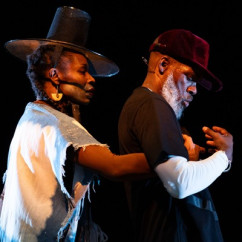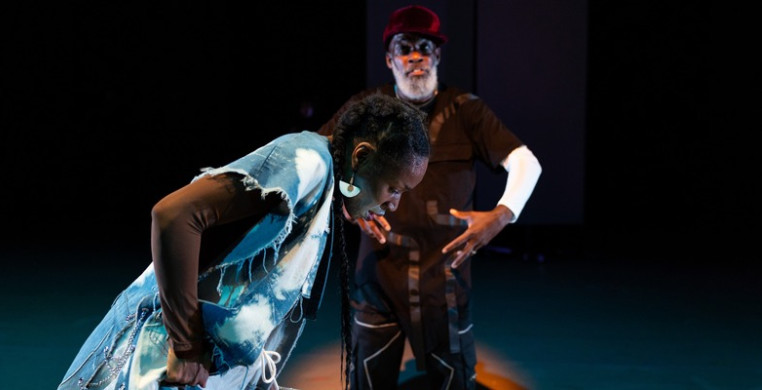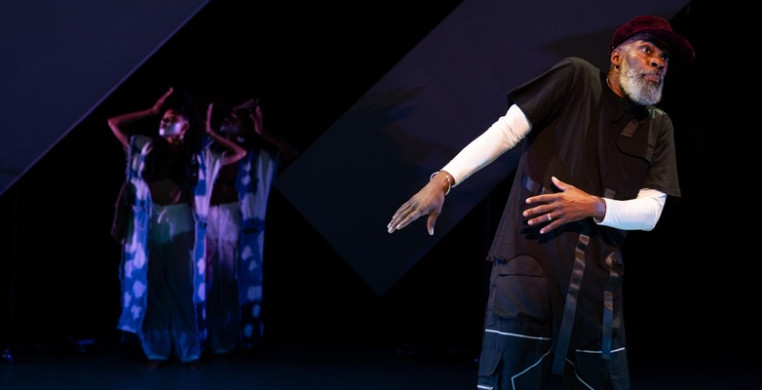What if an emcee were a prophet? While on the surface disparate, prophets and emcees share many common ideals and characteristics as communicators and influencers. Prophets convey spiritual truths and guidance to their followers, often with a sense of urgency and moral imperative. Similarly, emcees, particularly in hip-hop culture, serve as modern-day griots, using their lyrical prowess to convey narratives, social commentary and personal experiences to their audience.
Both prophets and emcees possess a gift for articulating compelling perspectives and capturing their audience’s attention and imagination. Anyone in attendance May 9-11 at “Prophet: The Order of the Lyricist” at the Museum of Contemporary Art bore witness to the storytelling gifts of 7NMS, the artistic coupling of husband and wife Everett Saunders and Marjani Forté-Saunders. While prophets draw on spiritual inspiration and emcees draw on personal experiences and societal observations, both wield their words to provoke thought, inspire action and shape the consciousness of their communities.
In “Prophet,” Saunders narrates his personal history and lineage as an emcee, creating a dialogue around socio-economic systems of race, spiritual practices and the journey of the young black man in America. Saunders brandishes his voice like a swordsman expertly maneuvering his blade in combat. He skillfully wields words to captivate the audience, striking with the power of imagination and emotion, relying on timing, volume, tonality and a deep understanding of his characters.
While Saunders’ ability to spit lines and weave rhythmic tapestries throughout the evening is an impressive talent, his true artistic brilliance is in bringing characters from his history to life. His ability to embody these characters transcends mere performance, as he delves deeply into the essence of each person to breathe life into every nuance and subtlety of their being. With a profound understanding of the character's motivations, fears, desires and complexities, Saunders executes his impersonations with an unwavering commitment to authenticity.
 Marjani Forté-Saunders & Everett Saunders; Photo by Angel Origgi
Marjani Forté-Saunders & Everett Saunders; Photo by Angel Origgi
Sunders illuminates three encounters from his young life that led to valuable mentorships and life lessons, titling the men King One, King Two and King Three.
In his telling of the story of King Two, a man named Otis, Saunders manifests three separate characters, demonstrating his ability to shape-shift before our very eyes. He begins the story by portraying a younger version of himself, losing his serene composure and his voice becoming more agitated. Saunders encounters Otis, a homeless man stationed outside a Wawa convenience store. As he begins to describe the man, he hunches his shoulders forward and portrays Otis’ toothless diction while lowering his gaze to the floor and gesturing with his arms toward the fares he is selling.
Saunders reveals to the audience that the current portrayal of Otis is a mask that the man dons for the “white people” who encounter him on the street. He then transforms his body, moving with more control and nuanced variations in his stance, speaking more clearly, and lifting his head with a subtle confidence to distinguish his second mask, the one he presents for the “melanized people”. Saunders glides between the three characters — Storyteller, Otis One and Otis Two — illustrating the tale so clearly that you feel Otis is truly on stage with him. Saunders transports us into the character's worlds, blurring the lines between reality and fiction, stirring emotions in the audience that linger past the curtain call.
If Saunders is the earthly representation of the stories being told, Forté-Saunders and dancer Marcella Lewis are avatars of the universe itself, observing and guiding him through the retelling of his history. Throughout the sixty-minute work, the dancers carve out the space for Saunders to exist, juxtaposing his pedestrian movements with post-modern choreography that echoes the rhythms in the sound score (composed by Saunder and co-composer Chris Williams). They manipulate the large mobile panels by moving them across the stage and flipping them horizontally and diagonally creating new planes for video (Media Designer & Filmmaker Meena Murugesan) and Saunders’ shadow.
 Marjani Forté-Saunders & Everett Saunders; Photo by Angel Origgi
Marjani Forté-Saunders & Everett Saunders; Photo by Angel Origgi
From the moment Forté-Saunders and Lewis step into the space, they signify something far greater than bodies dancing to the beat of the music and the flow of Saunders’ lines. Their presence in the space represents the rhythm of life, propelling Saunders and guiding his steps through the ebb and flow of time. Sometimes their movements are a gentle melody, soothing and reassuring, while in moments of Saunders’ strife, they are a wild force, unpredictable and chaotic.
Forté-Saunders draws the audience in as her spirit moves her body through the space like bottled lightning. Each movement is a bolt of brilliance, swift and incandescent, illuminating the space with an intensity that leaves spectators breathless. Her movements are swift and unpredictable, tracing arcs of beauty through the air with a mesmerizing fluidity that defies gravity. The performance is a testament to Forté-Saunder’s innate power and grace as she navigates the choreography with precision and vitality, harnessing the essence of a thunderstorm within her limbs.
“Prophet: The Order of the Lyricist” is part of the Museum Of Contemporary Art’s spring performance series, “On Stage: Resonance.” A program note by Curator Tara Aisha Willis explains that “through distinct ideas, practices, and forms, their works explore how sound resonates in, through, and from the body…and how lived experiences are voiced in society with resounding force.”
7NMS worked with the MCA for two years, building relationships with various organizations and artists in Chicago to further the work, collaborating with Bronzeville’s Miyagi Records to record an album unique to the performance. The rich creative process taken by 7NMS is apparent in the work. Its impact lingers long after the performance ends, leaving an indelible imprint on the hearts and minds of the audience, reminding us of the boundless capacity for creativity and empathy that defines our humanity.


